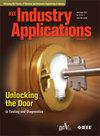Perception Method of Voltage Spatial-Temporal Distribution for EV Enriched Distribution Network: A Priority Adaptive DNN Enhancement Approach
IF 4.2
2区 工程技术
Q2 ENGINEERING, ELECTRICAL & ELECTRONIC
引用次数: 0
Abstract
With rapid growth of electric vehicles (EVs) and the integration of large-scale distributed energy sources in distribution networks (DNs), their stochastic and disorderly integration presents a significant challenge to real-time voltage perception. Accordingly, this paper puts forth a priority adaptive deep neural network (DNN) enhancement approach for voltage real-time perception, with the objective of establishing the spatial-temporal mapping relationship between bus voltage of DN with renewable energy, load, and EV data. Firstly, a DNN model is proposed as a solution to the problem of inaccurate voltage perception in EV-enriched DNs caused by the limitations of fuzzy power flow models. Then, to address the issue of the deep learning (DL) method's inability to achieve precise results in extreme circumstances, a power flow model is integrated with the DL method through iteration to support the voltage perception model in making well-informed decisions. And, in order to tackle the difficulties presented by large-scale, complex, non-convex, non-linear problems on resource-constrained devices, a mix precision DNN quantization method is proposed to enable the real-time, high-precision sensing of bus voltages in EV-rich DNs. Finally, the effectiveness of the proposed method is demonstrated by a 141-bus DN test case.电动汽车富集配电网电压时空分布感知方法:一种优先自适应深度神经网络增强方法
随着电动汽车(EV)的快速增长和大规模分布式能源在配电网(DN)中的集成,其随机性和无序集成给电压实时感知带来了巨大挑战。因此,本文提出了一种优先自适应深度神经网络(DNN)增强电压实时感知的方法,目的是建立配电网母线电压与可再生能源、负荷和电动汽车数据之间的时空映射关系。首先,针对模糊功率流模型的局限性造成的电动汽车丰富 DNs 电压感知不准确的问题,提出了 DNN 模型作为解决方案。然后,针对深度学习(DL)方法在极端情况下无法获得精确结果的问题,通过迭代将功率流模型与 DL 方法相结合,以支持电压感知模型做出明智的决策。此外,为了解决资源受限设备上的大规模、复杂、非凸、非线性问题所带来的困难,提出了一种混合精度 DNN 量化方法,以便在电动汽车丰富的 DNs 中实现母线电压的实时、高精度感知。最后,通过一个 141 总线 DN 测试案例证明了所提方法的有效性。
本文章由计算机程序翻译,如有差异,请以英文原文为准。
求助全文
约1分钟内获得全文
求助全文
来源期刊

IEEE Transactions on Industry Applications
工程技术-工程:电子与电气
CiteScore
9.90
自引率
9.10%
发文量
747
审稿时长
3.3 months
期刊介绍:
The scope of the IEEE Transactions on Industry Applications includes all scope items of the IEEE Industry Applications Society, that is, the advancement of the theory and practice of electrical and electronic engineering in the development, design, manufacture, and application of electrical systems, apparatus, devices, and controls to the processes and equipment of industry and commerce; the promotion of safe, reliable, and economic installations; industry leadership in energy conservation and environmental, health, and safety issues; the creation of voluntary engineering standards and recommended practices; and the professional development of its membership.
 求助内容:
求助内容: 应助结果提醒方式:
应助结果提醒方式:


